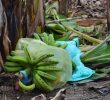The decline was attributed to the sluggish performances of the service, industry and agriculture sectors, the NSCB said.
By ALEX D. LOPEZ
Davao Today
DAVAO CITY, Philippines — “Region XI’s economy expanded at a slower pace of 4.1 percent last year compared to the 5 percent record in 2010,” said Estrella Turingan, head of the National Statistical Coordination Board (NSCB-XI) in a recent news briefing here.
The decline was attributed to the sluggish performances of the service, industry and agriculture sectors, the NSCB said.
“Growth rate of the service sector last year posted a 6.4 percent mark compared to the 7.4 percent in 2010 while the industry sector, at 2.5 percent compared to 4.2 in 2010,” Turingan added.
Real estate, renting and business sub-sectors under the service sector displayed the highest in value with a rate of 13 percent last year compared to 9.2 in 2010. It was followed by the transport, storage and communications sub-sectors with an 8.6 percent increase in 2011 from 2.7 in 2010.
Data also shows that although a wide increase was noted in the region’s manufacturing sector which shoot up to 10.4 percent from its previous record of 1.6, the sharp drop noted in mining, quarrying and construction sub-sectors failed to prop up the overall performance of the region’s industry sector which grew by 1 percent from 0.2 in 2010.
Maria Lourdes Lim, Director of the National Economic and Development Authority (Neda)-X1 pointed out that mining and quarrying sank deeper to negative 23.4 percent in 2011 from negative 1.9 in 2010 while construction suffered a sharp reversal from 107 percent in 2010 to negative 5.4 last year.
Lim said the decline in the production posted by small scale miners which make up about 98 percent of the region’s output took a toll on the region’s mining sector growth rate.
Small-scale miners’ cooperatives, she said, were no longer exempted from paying taxes, thus many of them no longer sell gold to the Bangko Sentral ng Pilipinas (Central Bank of the Philippines) since 2011.
Wilfredo Moncano, chief of the Mine Management Division of the Mines and Geosciences Bureau-(MGB) XI also affirmed that the imposition of withholding tax on cooperatives of small-scale miners crossed out the deliveries from small-scale miners.
“Nawala na yong deliveries from small-scale miners (Deliveries from small-scale miners were gone),” Moncano said, adding that another reason was the suspension of acceptance of new applications and processing of mineral agreements since March 2010, as mandated by MGB’s central office.
Least increase in agriculture
The agriculture sector of the region recorded the least growth, posting a 1 percent improvement compared to its previous 0.2 record.
Only 18 percent of the Davao Region’s economy is made up of agriculture, according to NSCB.
Improvements were noted in the production of palay, banana, pineapple, livestock and poultry. But it was sugarcane production that registered a robust leap from negative 51.1 in 2009-2010 to 108.4 percent in 2010-2011.
Palay production rose by 3.4 percent from its previous negative 5 record while banana production dropped to 1.3 percent from the previous 1.5 record.
Of its sub-groups, the agriculture and forestry sub-sectors attained 1.5 percent increase last year compared to 0.1 in 2010.
Log production also recorded a hike from a previous record of 20.2 to 20.8 percent.
The fishery sub-sector however nosedived to a negative 7.2 percent from 0.9 in 2010. The dwindling trend in the fishery sub-sector was attributed to the decrease of the volume of fish unloading.
Less fishes are caught “due to strong winds experienced and the frequent rain,” Neda’s Lim noted, adding that another factor is the climate change.
But Juland Suazo, spokesperson for environmental rights group Panalipdan told davaotoday.com that the decrease of the volume of fishes caught in Davao region can also be attributed to two factors namely, overfishing and the destruction of our coral reefs.
Overfishing, he said, refers to big and commercial fishing and not to the small fisher folk.
The Department of Science and Technology-XI, based on its study, confirmed the decreasing trend on the average catch of fishes over the years especially in Davao region.
Their study states that the decline is mainly due to “depleted fishery resources, pollution, fishermen competition, intrusion of commercial fishers to municipal waters and siltation caused by flooding.”
Short from target
Lim admitted that the region’s 2010 and 2011 Gross Regional Domestic Product (GRDP), or the value of goods and services produced by the regional economy within the specified period, which posted 5 and 4.1 percent, respectively, fell short from the 6.8 and 7.6 percent targets.
According to its previous economic design, the region’s GRDP targets were forecasted at 6.8 percent for 2010 and 7.6 percent in 2011.
Despite the slow performance last year, Davao region ranks numbers six in terms of growth rate in the whole country, two steps higher compared to the National Capital Region or Metro Manila with 0.5 percent growth rate.
Davao region is composed of four provinces namely, Davao del Sur, Davao del Norte, Compostela Valley and Davao Oriental. (Alex D. Lopez/davaotoday.com)










